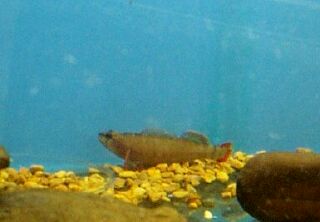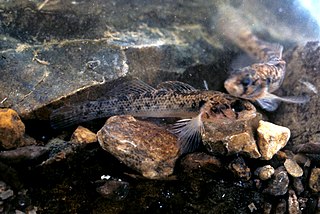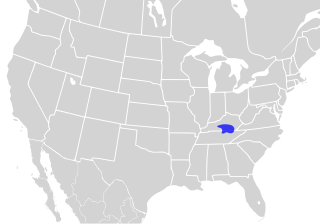The redband darter is a species of freshwater ray-finned fish, a darter from the subfamily Etheostomatinae, part of the family Percidae, which also contains the perches, ruffes and pikeperches. It is endemic to the state of Tennessee in the eastern United States.

The spotted darter is a species of freshwater ray-finned fish, a darter from the subfamily Etheostomatinae, part of the family Percidae, which also contains the perches, ruffes and pikeperches. It is endemic to the eastern United States where it occurs in the basin of the Ohio River. It inhabits fast-flowing rocky riffles of medium-sized and smaller rivers. This species can reach a length of 9 centimetres (3.5 in) TL though most only reach about 5.5 centimetres (2.2 in).

The yellowcheek darter is a species of freshwater ray-finned fish, a darter from the subfamily Etheostomatinae, part of the family Percidae, which also contains the perches, ruffes and pikeperches. It is endemic to the eastern United States where it is only known to occur in the state of Arkansas in the Little Red River. It inhabits medium-sized and smaller rivers in rocky riffles with strong current. This species can reach a length of 7.2 centimetres (2.8 in) TL though most only reach about 4.9 centimetres (1.9 in).

The striated darter is a species of freshwater ray-finned fish, a darter from the subfamily Etheostomatinae, part of the family Percidae, which also contains the perches, ruffes and pikeperches. It is endemic to the eastern United States. It occurs in the Duck River system in Tennessee. It inhabits rocky pools in creeks. This species can reach a length of 5.6 centimetres (2.2 in) TL though most only reach about 3.8 centimetres (1.5 in).
The Tuscumbia darter is a species of freshwater ray-finned fish, a darter from the subfamily Etheostomatinae, part of the family Percidae, which also contains the perches, ruffes and pikeperches. It is endemic to the southeastern United States where it occurs in well-vegetated springs along the Tennessee River in Alabama. This species can reach a length of 6.1 centimetres (2.4 in) TL though most only reach about 4 centimetres (1.6 in).

The boulder darter species of freshwater ray-finned fish, a darter from the subfamily Etheostomatinae, part of the family Percidae, which also contains the perches, ruffes and pikeperches. It is endemic to Alabama and Tennessee in the United States, where it occurs in the Elk River system and Shoal Creek. It is found in small rivers and fast-flowing streams, at least 2 ft (0.6 m) deep, with boulders or a rocky base. It feeds on aquatic insect larvae but little is known of its natural history. The population trend of this fish is unknown but it is affected by a rise in siltation and the impoundment of water within its range by the building of dams. The International Union for Conservation of Nature has assessed its conservation status as being "vulnerable".

The bluemask darter is a species of freshwater ray-finned fish, a darter from the subfamily Etheostomatinae, part of the family Percidae, which also contains the perches, ruffes and pikeperches. It is endemic to the eastern United States. It is a federally listed endangered species of the United States. This fish was not formally described until 2009, but it was added to the US Endangered Species List in 1993. During breeding, the male has bright blue patches on its head and other areas. This fish is found only in the Caney Fork River system, a tributary of the Cumberland River in Tennessee. The species name akatulo comes from the Cherokee for "mask", referring to the solid blue coloration on the lower face of the fish.

The Coosa darter is a species of freshwater ray-finned fish, a darter from the subfamily Etheostomatinae, part of the family Percidae, which also contains the perches, ruffes and pikeperches. It is endemic to the eastern United States.
Etheostoma duryi, the black darter, is a species of darter endemic to the eastern United States, where it occurs in the drainage of the Tennessee River in the states of Tennessee, Georgia, and Alabama. It is an inhabitant of rocky pools in streams and smaller rivers and their adjacent riffles. This species can reach a length of 7.2 cm (2.8 in), though most only reach about 5 cm (2.0 in). The specific epithet honors Charles Dury (1847-1931), who collected the original type specimens.
The saffron darter is a species of freshwater ray-finned fish, a darter from the subfamily Etheostomatinae, part of the family Percidae, which also contains the perches, ruffes and pikeperches. It is endemic to the eastern United States, where it is found in streams and creeks in Kentucky and Tennessee.

The Highland Rim darter is a species of freshwater ray-finned fish, a darter from the subfamily Etheostomatinae, part of the family Percidae, which also contains the perches, ruffes and pikeperches. It is endemic to the eastern United States, where it is only known to occur in Tennessee and Kentucky in the Barren River system. This species can reach a length of 5.6 centimetres (2.2 in) SL.

The headwater darter is a species of freshwater ray-finned fish, a darter from the subfamily Etheostomatinae, part of the family Percidae, which also contains the perches, ruffes and pikeperches. It is endemic to the eastern United States where it is found in Kentucky and Tennessee in the upper Green River system down to the Mud River, in the Cumberland River and upper Salt River systems. It is an inhabitant of streams up to about 5 metres (16 ft) wide with gravel or cobble substrates. Males of this species can reach a length of 6.2 centimetres (2.4 in) SL while females only reach 5.7 centimetres (2.2 in). The headwater darter was first formally described in 2002 by Patrick A. Ceas and Brooks M. Burr With the type locality given as Koger Creek, which is in the drainage of the Wolf River, about 0.8 kilometers northwest of Rolan, Kentucky along Kentucky Route 415 at the confluence of McIver Creek in Clinton County. The specific name honors the American ichthyologist Lawrence M. Page of the Florida Museum of Natural History.
The barcheek darter is a species of freshwater ray-finned fish, a darter from the subfamily Etheostomatinae, part of the family Percidae, which also contains the perches, ruffes and pikeperches. It is endemic to the eastern United States where it is only known to occur in the states of Kentucky and Tennessee in the Cumberland River drainage from the Big South Fork down to the Obey River. It is an inhabitant of smaller rivers, streams and creeks where it lives in small, rocky pools. This species can reach a length of 8.4 centimetres (3.3 in) TL though most only reach a length of 5 centimetres (2.0 in).
The sooty darter is a species of freshwater ray-finned fish, a darter from the subfamily Etheostomatinae, part of the family Percidae, which also contains the perches, ruffes and pikeperches. It is endemic the eastern United States. It is found in the Cumberland River basin where it is found only in the lower portion of the Caney Fork system and nearby tributaries in central Tennessee. It inhabits streams and creeks occurring in pools and their nearby riffles. This species can reach a length of 8 centimetres (3.1 in) TL though most only reach about 5 centimetres (2.0 in).
The firebelly darter is a species of freshwater ray-finned fish, a darter from the subfamily Etheostomatinae, part of the family Percidae, which also contains the perches, ruffes and pikeperches. It is endemic to the eastern United States, where it is only known to occur in the drainage systems of the Obion and Forked Deer rivers of Kentucky and Tennessee. It inhabits gravel or sand-bottomed pools in creeks up to small rivers. This species can reach a length of 7 centimetres (2.8 in) TL.

The orangethroat darter is a species of freshwater ray-finned fish, a darter from the subfamily Etheostomatinae, part of the family Percidae, which also contains the perches, ruffes and pikeperches. It is endemic to the central and eastern United States where it is native to parts of the Mississippi River Basin and Lake Erie Basin. Its typical habitat includes shallow gravel riffles in cooler streams and rocky runs and pools in headwaters, creeks, and small rivers, with sand, gravel, rubble, or rock substrates. It forages on the bottom for the aquatic larvae of midges, blackfly, mayfly and caddisfly, as well as isopods and amphipods. Spawning takes place in spring, the selected sites often being the upper stretches of riffles with sandy and gravelly bottoms interspersed with larger cobble. Reproductive success is high in this species. No particular threats have been identified, and the International Union for Conservation of Nature has assessed its conservation status as being of "least concern".
The spottail darter is a species of freshwater ray-finned fish, a darter from the subfamily Etheostomatinae, part of the family Percidae, which also contains the perches, ruffes and pikeperches. It is endemic to the eastern United States. It is found in the Ohio River basin and in the Red River system of the Cumberland River drainage. It inhabits rocky pools and nearby riffles of flowing waters up to the size of small rivers.
The bandfin darter is a species of freshwater ray-finned fish, a darter from the subfamily Etheostomatinae, part of the family Percidae, which also contains the perches, ruffes and pikeperches. It is endemic to the eastern United States. It occurs in tributaries of the lower Tennessee River system and uppermost Black Warrior River system. This species inhabits gravel and sandy pools in flowing waters up to the size of small rivers. It can reach a length of 7.1 centimetres (2.8 in) TL.
The striped darter is a species of freshwater ray-finned fish, a darter from the subfamily Etheostomatinae, part of the family Percidae, which also contains the perches, ruffes and pikeperches. It is found in the lower Cumberland River drainage in Kentucky and Tennessee, in the upper Caney Fork system in central Tennessee; and in Rockcastle River and nearby streams in eastern Kentucky. It inhabits rocky pools of headwaters, creeks and small to medium river. This species can reach a length of 7.8 cm (3.1 in), though most only reach about 4.8 cm (1.9 in).
The Tennessee darter is a species of freshwater ray-finned fish, a darter from the subfamily Etheostomatinae, part of the family Percidae, which also contains the perches, ruffes and pikeperches. It is endemic to the eastern United States, where it occurs in the Tennessee River drainage from western Virginia to western Tennessee. It also occurs in the upper Bluestone River drainage in western Virginia. It inhabits current-swept rocky pools and adjacent riffles of creeks and small to medium rivers. This species can reach a length of 6 cm (2.4 in).









